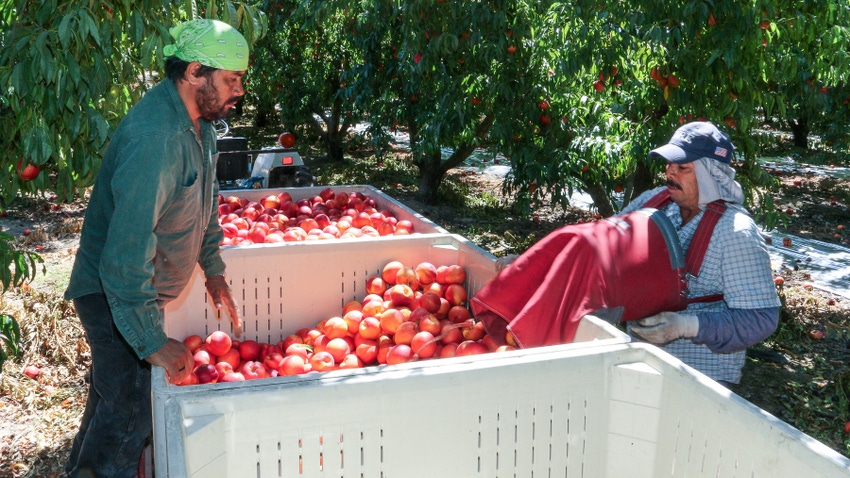
Despite low commodity prices in two of Fresno County’s primary crops, the region’s gross agricultural output inched slightly higher in 2022.
Fresno leads the state (and the U.S) in almond production, but poor producer prices for almonds dropped the commodity to No. 2 on the county’s list of top crops by value as grape production once again grossed the highest value in the annual crop and livestock report. Still, both crops individually achieved billion-dollar status. Thanks in part to higher stone fruit and milk prices, the county’s gross agricultural output rose $9.9 million to $8.09 billion last year.
Almond prices remain low, yet with nearly 25% of the state’s almond crop grown in Fresno County, gross receipts for the crop topped $1.14 billion from 636 million pounds of nuts produced. The average grower price for almonds last year fell nearly 16% to $1.57 per pound, far below the average retail price for almonds in the grocery store.
Fresno County’s almond acreage grew 5.7% on the year to over 302,000.
Conversely, stone fruit prices were much improved in 2022 over the previous year. Apricot prices were up almost 89% with nectarines up 41%. Plum prices rose over 32% from the previous year and peach prices varied between 15.5% higher for processed fruit to almost 39% higher for freestone peaches.
Ian LeMay, president, California Fresh Fruit Association, said that while grower returns were higher in 2022 for his members in Fresno County, those higher fruit prices came amidst inflationary pressures related to picking, shipping, and packing that fruit.
“The reality is our members may have been paid a few more dollars for their products, but as we know their input costs went up as well,” LeMay said. “It is getting more expensive to grow fresh produce in California. With that, the cost of our goods will need to exceed those costs for us to sustain our business.”
LeMay attributed the higher fruit prices in California to weather issues elsewhere in the U.S. that depressed crop yields and output.
Fresno County Agricultural Commissioner Melissa Cregan said she expected the county’s gross value to decline amidst poor almond prices.
“I’m surprised that we didn’t lose value because both of our top commodities declined in value,” she said.
Grape values took the top spot again in the county, which hasn’t been the case in over 10 years, according to Cregan’s office.
“It was interesting to see grapes take the top spot for the first time since about 2012,” said Ryan Jacobsen, CEO, Fresno County Farm Bureau. Jacobsen grows wine grapes and almonds southwest of Fresno.
All grapes were valued at more than $1.23 billion on the year, down 7% from the previous season. Raisin varieties lead the pack with over 82,000 acres of fruit harvested. While acreage fell 3%, yields year over year remained unchanged at about 10.6 tons per acre.
Raisin growers experienced softer prices for fresh and dried fruit.
The wine grape crush topped 701,000 tons at prices slightly higher than the previous year. Wine grape acreage fell slightly as yields remained unchanged at just under 13 tons per acre.
Table grapes were harvested from 31,840 acres on yields of about 10.5 tons per acre.
Pistachios remained solidly in third place among the top three commodities in the county, valued at more than $705.9 million on 186,000 tons of nuts produced.
Export markets
Fresno County’s leading agricultural exports include almonds, peaches, and oranges. Over 4,200 almond shipments totaling about 28% of the county’s almond crop were exported to global markets. About 14% of the county’s peach crop and nearly 9% of the region’s oranges were exported.
This year’s annual crop and livestock report highlighted the work of dog teams used to protect the county’s multibillion-dollar agricultural economy from invasive pests.
Because of their supreme sense of smell and ability to be trained to sniff out a variety of things, dogs have become an integral tool in the county’s fight to protect its agricultural economy, according to Cregan.
Cregan’s office is home to two agricultural dog detection teams. The K9s are used to inspect parcels for pests and agricultural materials. Parcels with food and plant materials coming into California are required to be labeled with their origins and the contents of the package, according to Cregan.
In 2009, the Fresno County Department of Agriculture’s dog team found Asian citrus psyllids (ACP) in passenger luggage that was being shipped from Fresno to India through a parcel facility. ACP nymphs in the luggage tested positive for Huanglongbing (HLB), the lethal citrus disease now sweeping through Southern California.
This was a year after the first ACP was discovered in San Diego County, and three years before the state’s first-ever find of HLB in a residential tree in Hacienda Heights, California.
In 2021 the dogs alerted on a package at a parcel facility with poisonous snakes, including two Puff Adders, two vipers, and an Eastern Diamondback Rattlesnake. Criminal charges were brought against the shipper and receiver by the California Department of Fish and Wildlife, Cregan said.
The snakes were reportedly shipped to the Fresno Chaffee Zoo for its reptile displays, and through that state and federal officials were able to track other illegal animal shipments coming from the same source in Michigan.
Perhaps more troubling than the poisonous snakes was the interception of two large boxes of bare-root Prunus species trees illegally imported from China. That led to the additional discovery of imported trees and vines on a Fresno County farm. Cregan says this is troubling because of the possibility of introducing plant invasive plant diseases and pests into the state.
Several hundred potted plants were ultimately destroyed by agricultural officials resulting from this find.
About the Author(s)
You May Also Like






